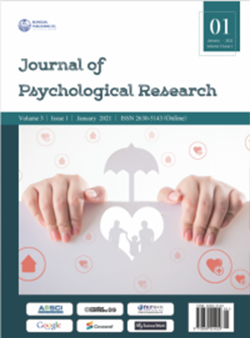-
577
-
554
-
334
-
333
-
324
Effect of Exercise and Sham Exercise Trackers on Perceived Workout Intensity and Mood in College Students
DOI:
https://doi.org/10.30564/jpr.v3i1.2541Abstract
Exercise is an essential contributor to both physical and mental health and is a significant part of a person’s overall lifestyle. With the increasing popularity of exercise trackers, researchers were interested in the effects of sham exercise trackers on perceptions of workouts and affect. Researchers predicted participants wearing a sham Fitbit band would report greater perceptions of workout intensity, challenge, and satisfaction compared to those without sham Fitbit bands. In addition, those wearing sham Fitbit bands were predicted to report greater positive affect and lower negative affect than those without bands. One hundred twenty student participants (60 in each group; one group with a sham Fitbit and one group with no Fitbit) were recruited from campus workout classes of Zumba, spinning, and body sculpting. Participants worked out and completed a PANAS survey, plus other workout perception questions. When using a sham Fitbit, participants believed the workout was more intense, physically challenging, and they were more satisfied with their workout. However, presence of a sham Fitbit band did not significantly affect mood. Results suggest that knowledge of wearing an exercise tracker, even without any workout data feedback, has an effect on workout perceptions, but has little effect on mood.
Keywords:
Exercise; Mood; Fitbit; PANAS; Zumba; Spinning; Body sculptingReferences
[1] Tylka, T. L., Homan, K. J. Exercise motives and positive body image in physically active college women and men: Exploring an expanded acceptance model of intuitive eating. Body Image, 2015, 15: 90-97. https://doi.org/10.1016/j.bodyim.2015.07.00
[2] Anderson, R. J., Brice, S. The mood-enhancing benefits of exercise: Memory biases augment the effect. Psychology of Sport and Exercise, 2011, 12(2): 79- 82.
[3] Eisenberg, M. H. The mediating role of internal motivation on the longitudinal influence of body satisfaction on physical exercise. Dissertation Abstracts International, 2015, 75(11-B): E.
[4] Ciccolo, J. T., Whitworth, J. W., Nosrat, S.Psychological benefits of exercise. In M. H. Anshel, S. J. Petruzzello, E. E. Labbé (Eds.), APA handbook of sport and exercise psychology, American Psychological Association, 2019. 2(Exercise psychology): 93- 108. https://doi.org/10.1037/0000124-005
[5] Medline Plus. Benefits of exercise. https://medlineplus.gov/benefitsofexercise.html
[6] Brickwood, K. J., Watson, G., O’Brien, J., Williams, A. D. Consumer-based wearable activity trackers increase physical activity participation: Systematic review and meta-analysis. JMIR MHealth and UHealth, 2019, 7(4): e11819. https://doi.org/10.2196/11819
[7] Smits, J. A. J., Otto, M. W. Exercise for mood and anxiety disorders: Therapist guide. Oxford University Press, 2009.
[8] Rethorst, C. D. Effects of exercise on depression and other mental disorders. In M. H. Anshel, S. J. Petruzzello, E. E. Labbé, M. H. Anshel (Ed), S. J. Petruzzello (Ed), E. E. Labbé (Ed) (Eds.), APA handbook of sport and exercise psychology, American Psychological Association, 2019, 2(Exercise psychology): 109- 121. https://doi.org/10.1037/0000124-006
[9] Knapen, J., Vancampfort, D., Moriën, Y., Marchal, Y. Exercise therapy improves both mental and physical health in patients with major depression. Disability and Rehabilitation, 2015, 37(16), 1490-1495. https://doi.org/10.3109/09638288.2014.972579
[10] Powers, M. B., Asmundson, G. J. G., Smits, J. A. J. Exercise for mood and anxiety disorders: The stateof-the science. Cognitive Behaviour Therapy, 2015, 44(4): 237-239. https://doi.org/10.1080/1650603.2015.1047286
[11] Campbell, C. R., White, K. G. Working it out: Examining the psychological effects of music on moderate-intensity exercise. Psi Chi Journal of Psychological Research, 2015, 20(2): 73-79.
[12] Rasmussen, M., Laumann, K. The role of exercise during adolescence on adult happiness and mood. Leisure Studies, 2014, 33(4), 341-356. https://doi.org/10.1080/02614367.2013.798347
[13] Broaddus, A. M., Jaquis, B. J., Jones, C. B., Jost, S. R., Lang, A. S. I. D., Li, A., Li, Q., Nelson, P. P., Spear, E. M. Fitbits, field-tests, and grades: The effects of a healthy and physically active lifestyle on the academic performance of first year college students. International Journal of Sport and Exercise Psychology, 2019. https://doi.org/10.1080/1612197X.2019.1623062
[14] Lindheimer, J. B., O’Connor, P. J., Dishman, R. K. Quantifying the sham effect in psychological outcomes of exercise training: A meta-analysis of randomized trials. Sports Medicine, 2015, 45(5): 693-711. https://doi.org/10.1007/s40279-015-0303-1
[15] Schlesinger, B. L. Exercise counting apparatus. United States Patent Office, 1955, 40(5): 20.
[16] Smith, W. A. Effect of incorporating the Fitbit fitness tracking technology into a prescribed exercise intervention program to improve long-term function in obese individuals one year following total knee arthroplasty. Dissertation Abstracts International, 2015, 76(5): 22-24.
[17] Wang, J. B., Cadmus-Bertram, L. A., Natarajan, L., White, M. M., Madanat, H., Nichols, J. F., Pierce, J. P. Wearable sensor/device (Fitbit One) and SMS text-messaging prompts to increase physical activity in overweight and obese adults: A randomized controlled trial. Telemedicine and E-Health, 2015, 21(10): 782-792. https://doi.org/10.1089/tmj.2014.0176
[18] Stanforth, D., Steinhardt, M., Mackert, M., Stanforth, P. R., Gloria, C. T. An investigation of exercise and the sham effect. American Journal of Health Behavior, 2011, 35(3): 257-268. https://doi.org/10.5993/AJHB.35.3.1
[19] American Psychological Association. Ethical principles of psychologists and code of conduct. American Psychologist, 2002, 57: 1060-1073.
[20] Watson, D., Clark, L. A., Tellegen, A. Positive and Negative Affect Schedule. PsycTESTS, 1988. https://doi.org/10.1037/t03592-000
[21] Myer, R. The quantified welp: A new study suggests that measuring activity makes in less enjoyable. The Atlantic, 2015, 30(2): 25.
[22] David, W., Clark, L. A. Positive and Negative Affect Schedule--Expanded Version. PsycTESTS, 1994. https://doi.org/10.1037/t04754-000
[23] Klaperski, S., Koch, E., Hewel, D., Schempp, A., Müller, J. Optimizing mental health benefits of exercise: The influence of the exercise environment on acute stress levels and wellbeing. Mental Health and Prevention, 2019, 15. https://doi.org/10.1016/j.mhp.2019.200173




 Elizabeth J. Scott
Elizabeth J. Scott





